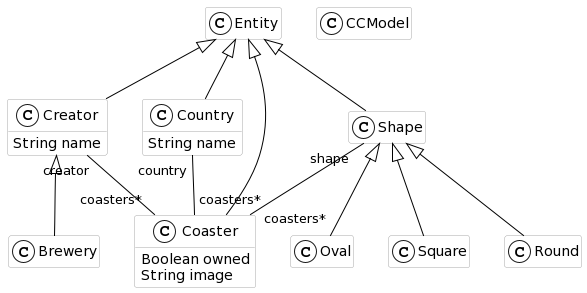This post is the first in a serie dedicated to Famix Tools
When creating or studying a meta-model, it is often convenient to be able to “see” it as a whole.
UML looks like a natural solution for this.
So in the past we had a tool to create UML diagrams of the meta-models through PlantUML (a small language and a tool to generate UML diagrams). The post Generate a plantUML visualization for a meta-model explained how to use this tool
But the tool had some limitations, one of which was that it was not easy to add a different backend than PlantUML.
Therefore, inspired by the previous tool, we redesigned a new one, FamixUMLDocumentor, with a simpler API and the possibility to add new backends.
Simple Use
We illustrate the use with the same Coaster example already used previously.
You can also experiment with FDModel, a small meta-model used for testing.
You can create a PlantUML script for a UML class of your metamodel with:
FamixUMLDocumentor new
model: CCModel ;
generate ;
exportWith: (FamixUMLPlantUMLBackend new).
The result will be a PlantUML script that you can paste into https://plantuml.org/ to get this UML class diagram:

FamixDocumentor API
The API for the documenter is as follow:
-
model:– adds a meta-model to export. Several meta-models can be exported jointly by adding them one after the other. By default each meta-model is automatically assigned a color in which its entities will be drawn. -
model:color:– same as previous but manually assign aColorto the meta-model. -
onlyClasses:– specifies a list of classes to export. It can replace the use ofmodel:. -
excludeClasses:– specifies a list of classes to exclude from the export. Typically used withmodel:to remove from the UML some of the meta-model’s classes. Can also be used to exlude “stub” classes (seebeWithStubs). -
beWithStubs– Indicates to also export the super-classes and used traits of exported classes, even if these super-classes/traits or not part of the meta-models. These stubs have an automatically selected color different from the meta-models displayed. -
beWithoutStubs– opposite of the preceding. This is the default option. -
generate– creates an internal representation of a UML class diagram according to the configuration created with the preceding messages. -
exportWith:– exports the internal representation with the “backend” given (for example:FamixUMLPlantUMLBackendin the example above)
FamixUML Backends
The backend is normally called by the FamixUMLDocumentor but can be called manually.
For example, the image above can be exported in a PlantUML script with:
documentor := FamixUMLDocumentor new.
documentor
model: CCModel ;
generate.
FamixUMLPlantUMLBackend new export: documentor umlEntities.
(Compare with the example given above)
Backends have only one mandatory method:
-
export:– Exports the collection of umlEntities (internal representation) in the format specific to the backend.
New backends can be created by subclassing FamixUMLAbstractBackend.
There is a FamixUMLRoassalBackend to export the UML diagram in Roassal (visible inside Pharo itself), and a FamixUMLMermaidBackend to export in Mermaid format (similar to PlantUML).
There is a FamixUMLTextBackend that outputs the UML class diagram in a textual form.
By default it returns a string but this can be changed:
-
toFile:– Instead of putting the result in a string, will write it to the file whose name is given in argument. -
outputStream:– specifies a stream on which to write the result of the backend.
FamixUMLPlantUMLBackend and FamixUMLMermaidBackend are subclasses of this FamixUMLTextBackend (therefore they can also export to a file).